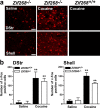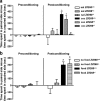Plasticity-associated gene Krox24/Zif268 is required for long-lasting behavioral effects of cocaine
- PMID: 16672671
- PMCID: PMC6674157
- DOI: 10.1523/JNEUROSCI.4601-05.2006
Plasticity-associated gene Krox24/Zif268 is required for long-lasting behavioral effects of cocaine
Erratum in
- J Neurosci. 2006 May 17;26(20):table of contents
Abstract
The extracellular signal-regulated kinases (ERKs) 1/2 pathway is stimulated by drugs of abuse in striatal neurons through coincident activation of dopamine D1 and glutamate NMDA receptors and is critical for long-lasting behavioral effects of these drugs. Although regulation of transcription is a major target of ERK, the precise mechanisms by which it contributes to behavioral alterations is not known. We examined the role of Zif268, an immediate-early gene induced by drugs of abuse under the control of ERK, in behavioral responses to cocaine using knock-in mutant mice in which Zif268 was replaced by LacZ. No biochemical or behavioral differences between mutant and wild-type mice were observed in basal conditions or in acute responses to cocaine injection. In contrast, locomotor sensitization to single or repeated cocaine injections was dramatically diminished in both heterozygous and homozygous Zif268 mutant mice. Conditioned place preference in response to cocaine was prevented in Zif268-deficient mice. This effect was not attributable to a general learning deficit because the mutant mice displayed normal conditioned place preference when food was used as reward. Our results provide direct genetic evidence for the requirement of Zif268 for long-lasting association of environmental context with specific behavioral responses after short exposures to cocaine. They also underline the common molecular machinery involved in long-lasting drug-induced behavioral alterations and the formation of other types of memory.
Figures




Similar articles
-
Cocaine-Dependent Acquisition of Locomotor Sensitization and Conditioned Place Preference Requires D1 Dopaminergic Signaling through a Cyclic AMP, NCS-Rapgef2, ERK, and Egr-1/Zif268 Pathway.J Neurosci. 2021 Jan 27;41(4):711-725. doi: 10.1523/JNEUROSCI.1497-20.2020. Epub 2020 Dec 2. J Neurosci. 2021. PMID: 33268547 Free PMC article.
-
Mechanisms of locomotor sensitization to drugs of abuse in a two-injection protocol.Neuropsychopharmacology. 2010 Jan;35(2):401-15. doi: 10.1038/npp.2009.143. Neuropsychopharmacology. 2010. PMID: 19759531 Free PMC article.
-
Neuronal scaffolding protein spinophilin is integral for cocaine-induced behavioral sensitization and ERK1/2 activation.Mol Brain. 2019 Feb 25;12(1):15. doi: 10.1186/s13041-019-0434-7. Mol Brain. 2019. PMID: 30803445 Free PMC article.
-
Involvement of the extracellular signal-regulated kinase cascade for cocaine-rewarding properties.J Neurosci. 2000 Dec 1;20(23):8701-9. doi: 10.1523/JNEUROSCI.20-23-08701.2000. J Neurosci. 2000. PMID: 11102476 Free PMC article.
-
Contributions of ERK signaling in the striatum to instrumental learning and performance.Behav Brain Res. 2011 Mar 17;218(1):240-7. doi: 10.1016/j.bbr.2010.12.010. Epub 2010 Dec 13. Behav Brain Res. 2011. PMID: 21147168 Free PMC article. Review.
Cited by
-
Egr-1 induces DARPP-32 expression in striatal medium spiny neurons via a conserved intragenic element.J Neurosci. 2012 May 16;32(20):6808-18. doi: 10.1523/JNEUROSCI.5448-11.2012. J Neurosci. 2012. PMID: 22593050 Free PMC article.
-
Darpp-32 and t-Darpp protein products of PPP1R1B: Old dogs with new tricks.Biochem Pharmacol. 2019 Feb;160:71-79. doi: 10.1016/j.bcp.2018.12.008. Epub 2018 Dec 12. Biochem Pharmacol. 2019. PMID: 30552871 Free PMC article. Review.
-
Implication of CCR2 chemokine receptor in cocaine-induced sensitization.J Mol Neurosci. 2011 Jul;44(3):147-51. doi: 10.1007/s12031-011-9508-4. Epub 2011 Mar 22. J Mol Neurosci. 2011. PMID: 21424761
-
Cocaine modulation of frontostriatal expression of Zif268, D2, and 5-HT2c receptors in high and low impulsive rats.Neuropsychopharmacology. 2013 Sep;38(10):1963-73. doi: 10.1038/npp.2013.95. Epub 2013 May 1. Neuropsychopharmacology. 2013. PMID: 23632436 Free PMC article.
-
Increased conditioned place preference for cocaine in high anxiety related behavior (HAB) mice is associated with an increased activation in the accumbens corridor.Front Behav Neurosci. 2014 Dec 22;8:441. doi: 10.3389/fnbeh.2014.00441. eCollection 2014. Front Behav Neurosci. 2014. PMID: 25566008 Free PMC article.
References
-
- Baunez C, Dias C, Cador M, Amalric M (2005). The subthalamic nucleus exerts opposite control on cocaine and “natural” rewards. Nat Neurosci 8:484–489. - PubMed
-
- Berke JD, Hyman SE (2000). Addiction, dopamine, and the molecular mechanisms of memory. Neuron 25:515–532. - PubMed
-
- Bhat RV, Cole AJ, Baraban JM (1992). Chronic cocaine treatment suppresses basal expression of zif268 in rat forebrain: in situ hybridization studies. J Pharmacol Exp Ther 263:343–349. - PubMed
-
- Bozon B, Davis S, Laroche S (2003). A requirement for the immediate early gene zif268 in reconsolidation of recognition memory after retrieval. Neuron 40:695–701. - PubMed
Publication types
MeSH terms
Substances
LinkOut - more resources
Full Text Sources
Molecular Biology Databases
Miscellaneous
